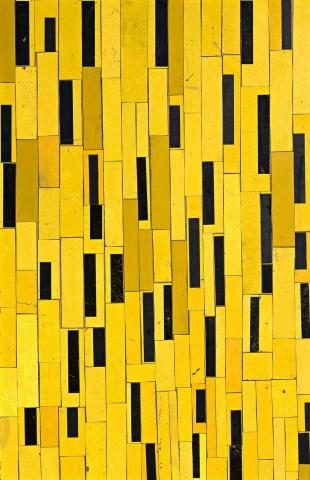DOWNBEAT, 1997
Rosalie Gascoigne
retro-reflective road signs on wood
122.0 x 79.0 cm
signed, dated and inscribed verso: Rosalie Gascoigne / 1997 / DOWNBEAT
Roslyn Oxley9 Gallery, Sydney (label attached verso)
Private collection, Sydney
Deutscher~Menzies, Melbourne, 4 June 2003, lot 22
Art Galleries Schubert, Queensland (label attached verso)
Private collection, Queensland, purchased from the above in 2006
Rosalie Gascoigne, Roslyn Oxley9 Gallery, Sydney, 1 April – 2 May 1998, cat. 5 (label attached verso)
Rosalie Gascoigne Retrospective Exhibition, National Gallery of Victoria, Melbourne, 19 December 2008 – 15 March 2009
Gellatly, K., Rosalie Gascoigne, Council of Trustees of the National Gallery of Victoria, Melbourne, 2008, pp. 136 and 106 (illus.)
The art of Rosalie Gascoigne is a celebration of the nature of material, and of how the artist as 'transmitter' and the viewer as 'receiver' can instil meaning, experience and significance into the seemingly mundane. In this sense, it is of particular interest to note that prior to Gascoigne's appearance in the world of art galleries and fine art exhibitions, the outlet for her creativity was Ikebana, a style of Japanese flower arrangement which integrated foliage and flowers with 'found material'. Her teacher, an Ikebana Master and exponent of the modern 'Sogetsu School', Norman Sparnon, described the philosophy as 'embodied in two Japanese words: seishin, meaning "spirit" and chowa, "harmony".1
Gascoigne's training, and increasing mastery of this highly disciplined field unleashed a curiosity and investigation into a form of art more 'relevant' to her time and place. As Kelly Gellatly explains, 'She experienced an affinity to its immersion in and response to the natural world, but eventually became disillusioned, as her confidence in her own abilities grew, with its hierarchical approach and deference to "all things Japanese", particularly with regards to the selection and use of materials: "I thought the Australian landscape offered a lot more that I would like to say. No way were you going to be cramped into a Japanese culture when out there it was more marvellous."2
A remarkable career was to follow: from her first solo 'fine art' exhibition in 1974 at Macquarie Galleries, Canberra, it was only four years until the National Gallery of Victoria presented a major survey exhibition of Gascoigne's work3 and within four more years she had represented Australia at the 1982 Venice Biennale. Along the way her work developed, generally from three-dimensional assemblage to two dimensions, though her innate ability to arrange, re-present and reincarnate her foraged, naturally weathered materials remained her extraordinary talent.
In 2008, the National Gallery of Victoria again honoured the artist with a major retrospective exhibition, which included Downbeat, the work on offer, as a prime example of Gascoigne's late retro-reflective works. A 'signature' piece, the subtleties in its composition, of the underlying diagonal cross of the cut ends of the wooden pieces overlaid with the rhythmic 'beats' of the black 'notes', further enlivened by the changing flashes of reflected light as the viewer moves, it is a work that Gascoigne has arranged for our participation in a remarkable visual harmony.
1. Gellatly, K., Rosalie Gascoigne, Council of Trustees of the National Gallery of Victoria, Melbourne, 2008, p. 11
2. Ibid.
3. Survey 2: Rosalie Gascoigne, National Gallery of Victoria, Melbourne, 29 April 1978 - 4 June 1978
